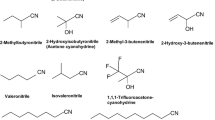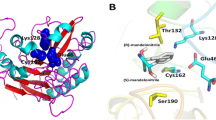Abstract
The highly enantioselective arylacetonitrilase of Pseudomonas putida was purified to homogeneity using a combination of (NH4)2SO4 fractionation and different chromatographic techniques. The enzyme has a molecular weight of 412 kDa and consisted of approximately nine to ten identical subunits (43 kDa). The purified enzyme exhibited a pH optimum of 7.0 and temperature optimum of 40°C. The nitrilase was highly susceptible to thiol-specific reagents and metal ions and also required a reducing environment for its activity. These reflected the presence of a catalytically essential thiol group for enzyme activity which is in accordance with the proposed mechanism for nitrilase-catalyzed reaction. The enzyme was highly specific for arylacetonitriles with phenylacetonitrile and its derivatives being the most preferred substrates. Higher specificity constant (k cat/K m) values for phenylacetonitrile compared to mandelonitrile also revealed the same. Faster reaction rate achieved with this nitrilase for mandelonitrile hydrolysis was possibly due to the low activation energy required by the protein. Incorporation of low concentration (<5%) of organic solvent increased the enzyme activity by increasing the availability of the substrate. Higher stability of the enzyme at slightly alkaline pH and ambient temperature provides an excellent opportunity to establish a dynamic kinetic resolution process for the production of (R)-(−)-mandelic acid from readily available mandelonitrile.





Similar content being viewed by others
References
Banerjee A, Sharma R, Banerjee UC (2002) Nitrile degrading enzymes: current status and future prospects. Appl Microbiol Biotechnol 60:33–44
Banerjee A, Sharma R, Banerjee UC (2003a) A rapid and sensitive fluorometric assay method for the determination of nitrilase activity. Biotechnol Appl Biochem 37:289–293
Banerjee A, Kaul P, Sharma R, Banerjee UC (2003b) A high-throughput amenable colorimetric assay for enantioselective screening of nitrilase producing microorganisms. J Biomol Screen 8:559–565
Bartel B, Fink GR (1994) Differential regulation of an auxin producing nitrilase gene family in Arabidopsis thaliana. Proc Natl Acad Sci USA 91:6649–6653
Bestwick LA, Gronning LM, James DC, Bones A Rossiter JT (1993) Purification and characterization of a nitrilase from Brassica nupus. Physiol Plant 89:811–816
Bradford MM (1976) A rapid and sensitive method for the quantitation of microgram quantities of protein, utilizing the principle of protein dye binding. Anal Biochem 72:248–254
Brady D, Beeton A, Zeevart J, Kgaje C, VanRantwijk F, Sheldon RA (2004) Characterization of nitrilase and nitrile hydratase biocatalytic systems. Appl Microbiol Biotechnol 64:76–85
Brenner C (2002) Catalysis in the nitrilase superfamily. Curr Opin Struct Biol 12:775–782
Guilbault GG, Kramer DN (1966) Ultra sensitive, specific method for cyanide using p-nitrobenzaldehyde and o-dinitrobenzene. Anal Chem 38:834–836
Harper DB (1977a) Fungal degradation of aromatic nitriles: enzymology of C-N cleavage by Fusarium solani. Biochem J 167:685–692
Harper DB (1977b) Microbial metabolism of aromatic nitriles: enzymology of C-N cleavage by Nocardia sp. NCIB 11216. J Biochem 165:309–319
Harper DB (1985) Characterization of a nitrilase from Nocardia sp. (Rhodococcus group) NCIB 11215, using p-hydroxybenzonitrile as sole carbon source. Int J Biochem 17:677–683
Heinemann U, Engels D, Burger S, Kiziak C, Mattes R, Stolz A (2003) Cloning of a nitrilase gene from the cyanobacterium Synechocystis sp. strain PCC6803 and heterologus expression and characterization of the encoded protein. Appl Environ Microbiol 69:4359–4366
Kakeya H, Sakai N, Sugai T, Ohta H (1991) Preparation of optically active alpha-hydroxy acid derivatives by microbial hydrolysis of cyanohydrins and its application to the synthesis of (R)-4-dodecanolide. Agric Biol Chem 55:1877–1881
Kato Y, Ool R, Asano Y (2000) Distribution of aldoxime dehydratase in microorganisms. Appl Environ Microbiol 66:2290–2296
Kaul P, Banerjee A, Mayilraj S, Banerjee UC (2004) Screening for enantioselective nitrilases: Kinetic resolution of racemic mandelonitrile to (R)-(-)-mandelic acid by new bacterial isolates. Tetrahedron Asymmetry 15:207–211
Kobayashi M, Nagasawa T, Yamada H (1989) Nitrilase of Rhodococcus rhodochrous J1: purification and characterization. Eur J Biochem 182:349–356
Kobayashi M, Yanaka N, Nagasawa T, Yamada H (1990) Purification and characterization of a novel nitrilase of Rhodococcus rhodochrous K22 that acts on aliphatic nitriles. J Bacteriol 172:4807–4815
Kobayashi M, Goda M, Shimizu S (1998) Nitrilase catalyzes amide hydrolysis as well as nitrile hydrolysis. Biochem Biophys Res Commun 253:662–666
Lammeli UK (1970) Cleavage of structural proteins during the assembly of the head of the bacteriophage T4. Nature 227:680–685
Layh N, Willetts A (1998) Enzymatic nitrile hydrolysis in low water systems. Biotechnol Lett 20:329–331
Layh N, Stolz A, Forster S, Effenberger F, Knackmuss H-J (1992) Enantioselective hydrolysis of o-acetylmandelonitrile to o-acetylmandelic acid by bacterial nitrilases. Arch Microbiol 158:405–411
Layh N, Parratt J, Willetts A (1998) Characterization and partial purification of an enantioselective arylacetonitrilase from Pseudomonas fluorescens DSM 7155. J Mol Catal B Enzym 5:467–474
Merril CR, Goldman D, Sedman SA, Ebert MH (1981) Ultrasensitive stain for proteins in polyacrylamide gels shows regional variations in cerebrospinal fluid proteins. Science 211:1437–1438
Mylerova V, MartÍnková L (2003) Synthetic applications of nitrile converting enzymes. Curr Org Chem 7:1–17
Nagasawa T, Ryuno K, Yamada H (1986) Nitrile hydrarase of Brevibacterium sp. R312: Purification and characterization. Biochem Biophys Res Commun 139:1305–1312
Nagasawa T, Nanba H, Ryuno K, Takeuchi K, Yamada H (1987) Nitrile hydratase of Pseudomonas chlororaphis B23: Purification and characterization. Eur J Biochem 162:691–698
Nagasawa T, Mauger J, Yamada H (1990) A novel nitrilase, arylacetonitrilase, of Alcaligenes faecalis JM3, purification and characterization. Eur J Biochem 194:765–772
Nagasawa T, Wieser M, Nakamura T, Iwahara H, Yoshida T, Gekko K (2000) Nitrilase of Rhodococcus rhodochrous J1, conversion into the active form by subunit association. Eur J Biochem 267:138–144
O’Reilly C, Turner PD (2003) The nitrilase family of CN hydrolysing enzymes- a comparative study. J Appl Microbiol 95:1161–1174
Piotrowski M, Schonfelder S, Weiler EW (2001) The Arabidopsis thaliana isogene NIT4 and its orthologs in tobacco encode β-cyano L-alanine hydratase/nitrilase. J Biol Chem 276:2616–2621
Singh R, Banerjee A, Kaul P, Barse B, Banerjee UC (2005) Release of enantioselective nitrilase from Alcaligenes faecalis MTCC126: a comparative study. Bioprocess Biosyst Eng (in press). DOI 10.1007/s00449–005-0013-4
Stevenson DE, Feng R, Dumas F, Groleau D, Mihoc A, Storer AC (1992) Mechanistic and structural studies on Rhodococcus ATCC 39484 nitrilase. Biotechnol Appl Biochem 15:283–302
Wieser M, Heinzmann K, Kiener A (1997) Bioconversion of 2-cyanopyrazine to 5-hydroxypyrazine-2-carboxylic acid with Agrobacterium sp. DSM 6336. Appl Microbiol Biotechnol 48:174–176
Yamamoto K, Oishi K, Fujimatsu I, Komatsu KI (1991) Production of (R)-(-)-mandelic acid from mandelonitrile by Alcaligenes faecalis ATCC 8750. Appl Environ Microbiol 57:3028–3032
Yamamoto K, Fujimatsu I, Komatsu K (1992) Purification and characterization of the nitrilase from Alcaligenes faecalis ATCC 8750 responsible for enantioselective hydrolysis of mandelonitrile. J Ferment Bioeng 73:425–430
Acknowledgement
A. Banerjee and P. Kaul gratefully acknowledge the fellowship provided by CSIR, Govt. of India. This is NIPER communication number 347.
Author information
Authors and Affiliations
Corresponding author
Rights and permissions
About this article
Cite this article
Banerjee, A., Kaul, P. & Banerjee, U.C. Purification and characterization of an enantioselective arylacetonitrilase from Pseudomonas putida . Arch Microbiol 184, 407–418 (2006). https://doi.org/10.1007/s00203-005-0061-9
Received:
Revised:
Accepted:
Published:
Issue Date:
DOI: https://doi.org/10.1007/s00203-005-0061-9




